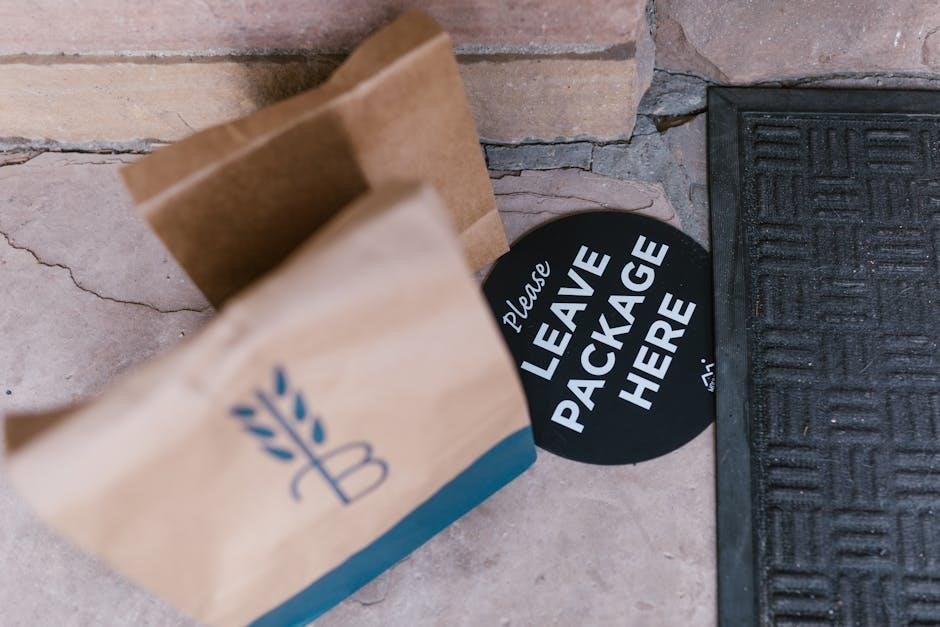The ShelterLogic 10×20 instructions provide a comprehensive guide for assembling and maintaining a durable, versatile shelter. Designed for protection and ease of use, this shelter offers a step-by-step assembly process to ensure a successful setup. With its sturdy frame and weather-resistant cover, it is ideal for outdoor storage, events, or seasonal protection. Follow these instructions carefully to achieve a secure and functional structure.
Overview of ShelterLogic 10×20 Shelter
The ShelterLogic 10×20 shelter is a durable and versatile structure designed for outdoor protection and storage. It provides a spacious 10×20 foot area, ideal for vehicles, equipment, or event setups. Constructed with high-quality materials, it ensures long-lasting performance against sun, rain, and wind. The shelter features a sturdy frame and a custom-fitted fabric cover, offering excellent protection and ease of assembly. Its compact yet robust design makes it suitable for various applications, from residential use to commercial settings. Proper anchoring and maintenance ensure stability and safety, making it a reliable choice for seasonal or permanent installations.
Importance of Following Assembly Instructions
Following the ShelterLogic 10×20 assembly instructions is crucial for ensuring a safe, stable, and functional structure. Proper assembly prevents damage to the shelter and its contents, while also safeguarding against potential hazards. Misaligned poles, loose bolts, or improperly secured covers can lead to structural issues and safety risks. Always read the manual thoroughly before starting, as it provides essential steps for securing the frame, attaching the cover, and anchoring the shelter. Failure to follow instructions may result in a compromised structure that cannot withstand weather conditions. Adhering to the guidelines ensures a durable and reliable shelter for years to come.

Pre-Assembly Preparation
Before assembling your ShelterLogic 10×20 shelter, ensure you have all tools and materials ready. Choose a flat, dry site and unpack all parts carefully. Organize components to streamline the process, referencing the manual for clarity. Proper preparation ensures a smooth and efficient assembly experience.
Tools and Materials Required
To successfully assemble your ShelterLogic 10×20 shelter, gather essential tools and materials. Required tools include a wrench, screwdriver, hammer, utility knife, and measuring tape. Materials needed are all hardware components, frame poles, fabric cover, anchors, ropes, and tarps. Ensure all parts from the kit are included and undamaged. Additional items like gloves and a ladder may aid assembly. Proper organization of these tools and materials will streamline the process and reduce assembly time. Always refer to the manual for specific requirements to avoid delays or complications during setup.

Site Selection and Preparation
Select a flat, level site for your ShelterLogic 10×20 shelter to ensure stability and proper assembly; Measure the area to confirm it accommodates the 10×20 footprint. Clear the site of debris, rocks, and obstructions to prevent damage to the cover and frame. Ensure the ground is firm and dry for secure anchoring. Avoid low-lying areas prone to water accumulation, as this can compromise the shelter’s integrity. Proper site preparation is crucial for a safe and successful assembly process. Always follow the manufacturer’s recommendations for optimal results.
Unpacking and Inventory of Parts
Begin by carefully unpacking all components from the boxes. Cross-reference each item with the provided parts list to ensure everything is included and undamaged. Check for the frame pieces, roof poles, bolts, screws, fabric cover, and anchoring hardware. Verify that all small parts, such as nuts and washers, are accounted for. If any items are missing or damaged, contact ShelterLogic customer support immediately. Organize the parts by category to streamline the assembly process. Keep the instruction manual nearby for quick reference. Proper inventory ensures a smooth and efficient assembly experience, avoiding delays or setbacks during construction.

Understanding the Assembly Process
Understanding the ShelterLogic 10×20 assembly process ensures a smooth setup. Follow the systematic guide for a sturdy and reliable shelter, from frame to cover, ensuring durability and protection.

Step-by-Step Assembly Overview
The ShelterLogic 10×20 shelter assembly begins with unpacking and organizing parts. Start by assembling the base structure, ensuring all poles are securely connected. Next, attach the roof and side poles, followed by tightening all bolts for stability. After the frame is complete, carefully fit the fabric cover, securing it with straps and ties. Finally, tighten the cover evenly and anchor the shelter to ensure safety and durability. Proper anchoring is crucial to withstand weather conditions, and following each step meticulously ensures a successful setup.
Time and Labor Requirements
Assembling the ShelterLogic 10×20 shelter typically requires approximately 2 hours for completion. It is recommended to have at least 3 individuals assisting, as the process involves handling large parts and ensuring proper alignment. While the instructions are designed for ease of use, having multiple people helps streamline the assembly, especially when fitting the cover and securing the frame. Allocating sufficient time and labor ensures a smooth setup and prevents potential issues. Proper preparation and teamwork are key to achieving a sturdy and functional shelter within the suggested timeframe.
Recommended Number of People for Assembly
For a smooth and efficient assembly of the ShelterLogic 10×20 shelter, it is recommended to have at least 2 to 3 people assisting. This ensures that larger parts, such as the frame and cover, can be handled safely and securely. Having multiple individuals allows for better coordination when aligning components and tightening hardware. Additionally, teamwork helps prevent accidents and ensures the structure is assembled correctly. While it is possible to complete the assembly with fewer people, having extra hands significantly simplifies the process and reduces the risk of errors. Proper teamwork enhances safety and efficiency.

Frame Assembly
The frame assembly involves attaching the base structure and securing the roof and side poles; Ensure all bolts are tightly fastened for stability and safety.
Assembling the Base Structure
Begin by laying out the base structure on a flat surface, ensuring all components are aligned properly. Use the provided hardware to secure the legs and connectors. Tighten all bolts firmly to create a sturdy foundation. Make sure the frame is square by measuring diagonally from corner to corner. If the measurements are equal, the base is properly aligned. Avoid over-tightening, as this may damage the hardware. Once the base is assembled, proceed to attach the roof and side poles, ensuring a secure connection. Proper assembly of the base structure is critical for the overall stability of the shelter.
Attaching the Roof and Side Poles
Once the base structure is secure, attach the side poles to the base connectors using the provided bolts. Ensure each pole is upright and evenly spaced. Next, connect the roof poles to the top of the side poles, aligning them carefully. Use the roof connectors to secure the poles together, forming the canopy frame. Tighten all bolts firmly to maintain structural integrity. Be cautious of sharp pole ends and ensure all hardware is properly seated. Double-check the alignment to ensure the roof sits evenly and the shelter remains stable. Properly attaching the roof and side poles is essential for a sturdy and weather-tight structure.
Securing the Frame with Bolts and Hardware
After assembling the base and roof poles, secure the frame using the provided bolts and hardware. Insert bolts through pre-drilled holes and tighten them firmly to ensure stability. Use a wrench or socket to tighten all connections evenly. Double-check that all joints are aligned properly and the frame is square. Ensure no hardware is loose, as this could compromise the shelter’s structural integrity. Pay special attention to corner connections, as they bear significant weight. Properly securing the frame with bolts and hardware is critical for withstanding wind and weather conditions, ensuring long-term durability and safety.

Cover Installation
Fitting the fabric cover to the frame requires careful alignment and securing with straps and ties. Ensure the cover is tight and properly attached for optimal weather protection.
Fitting the Fabric Cover to the Frame
Begin by aligning the fabric cover with the frame, ensuring the ShelterLogic logo is correctly positioned. Drape the cover evenly over the structure, starting from the top and working downward. Secure the edges bytightening the straps and ties to prevent sagging. Use the provided ropes to pull the fabric taut, ensuring a snug fit. Proper alignment is crucial to avoid wrinkles and stress points. Make sure the cover is centered and evenly spaced around the frame for optimal weather resistance and durability; Tightening should be done gradually to maintain even tension across the entire surface.
Securing the Cover with Straps and Ties
Once the fabric cover is properly fitted, secure it using the provided straps and ties. Start by attaching the straps to the frame’s designated points, ensuring they are tightly fastened. Tighten the straps gradually, working from one side to the other, to maintain even tension. Use the tie-down ropes to further secure the edges, wrapping them around the frame and tying them firmly. This ensures the cover remains taut and resistant to wind and weather. Regularly check and adjust the straps to prevent sagging and ensure optimal performance. Proper securing is essential for durability and safety, so follow the manufacturer’s guidelines carefully.
Tightening the Cover for Optimal Fit
Tightening the cover is crucial for ensuring a snug and secure fit on the ShelterLogic 10×20 frame. Begin by adjusting the straps and ties evenly, pulling the fabric taut from all sides. Use the provided tensioning tool to tighten the straps gradually, starting from the center and working outward. Ensure no wrinkles or sagging areas remain, as these can lead to damage in windy or wet conditions. Check the cover’s tightness by gently tugging on it; it should feel firm and stable. Regularly inspect and tighten the cover to maintain its integrity and extend the shelter’s lifespan. Proper tension ensures optimal performance and durability.

Anchoring the Shelter
Anchoring the ShelterLogic 10×20 shelter is essential for stability and safety, preventing damage from wind and weather. Use recommended anchors like ground stakes or auger anchors, ensuring they are suitable for your soil type. Distribute anchors evenly, typically one at each corner and additional along the sides for larger structures. Tighten the cover before anchoring to avoid extra strain. Regular maintenance is crucial; check anchors after severe weather for looseness. Consider additional accessories like straps for enhanced security. Proper anchoring ensures the shelter remains secure and durable, protecting your investment effectively.
Importance of Proper Anchoring
Proper anchoring is critical for the stability and safety of your ShelterLogic 10×20 shelter. Without secure anchoring, the structure may collapse or shift due to wind or weather conditions. Anchoring ensures the shelter remains firmly grounded, protecting both the shelter and its contents from damage. Manufacturer instructions emphasize that improper anchoring can lead to structural failure and void warranties. Regular checks and maintenance of anchors are essential, especially after severe weather. Proper anchoring not only extends the lifespan of the shelter but also ensures it remains a safe and reliable solution for outdoor storage or events.
Recommended Anchoring Methods
For the ShelterLogic 10×20 shelter, recommended anchoring methods include using auger anchors for soft ground, ground spikes for grass or dirt, and concrete anchor kits for permanent setups. Ensure anchors are spaced evenly around the shelter’s perimeter, typically every 3-4 feet. Tighten straps securely to maintain cover tension and prevent flapping. For added stability, tie-down kits with ratchet straps can be used. Always follow the manufacturer’s guidelines for specific anchoring solutions based on your location and weather conditions to ensure maximum stability and safety. Regular inspections of anchors are crucial to maintain the shelter’s integrity over time.
Ensuring Stability and Safety
Ensuring stability and safety involves proper anchoring, regular inspections, and maintaining a tight cover. Always check for level ground and compact the surface before assembly. Tighten straps and bolts firmly to prevent loose parts. Regularly inspect the frame, cover, and anchors for wear or damage. Address any issues promptly to avoid structural compromise. Keep the shelter well-ventilated to prevent moisture buildup. Follow weight limits for snow and wind loads as specified in the manual. By adhering to these guidelines, you can ensure your ShelterLogic 10×20 shelter remains stable and safe for years to come.

Additional Features and Accessories
Enhance your ShelterLogic 10×20 shelter with optional accessories like vents, windows, and doors for improved ventilation and accessibility. Custom fabric covers and storage bags are also available.
Installing Vents and Windows
Installing vents and windows in your ShelterLogic 10×20 shelter enhances ventilation and natural light. Begin by unpacking the vent and window kits, ensuring all hardware is included. Position the vents and windows on the shelter’s frame according to the manufacturer’s alignment guidelines. Use the provided screws and brackets to secure them tightly. Ensure the areas around the installations are clean and dry to maintain water resistance. Tighten all fasteners firmly but avoid overtightening, which could damage the fabric. Once installed, inspect the seals for any gaps. Properly aligned vents and windows improve airflow and visibility, ensuring a dry, well-ventilated space. Follow the manual for precise alignment with the ShelterLogic logo for optimal results. This step is crucial for both functionality and durability, ensuring your shelter remains in great condition for years to come.
Adding Doors and Other Accessories
Adding doors and other accessories to your ShelterLogic 10×20 shelter enhances functionality and convenience. Begin by unpacking the door kit and identifying all components. Attach the door frame to the shelter’s base using the provided brackets and bolts, ensuring a secure fit. Align the door with the opening, then fasten it using the included hardware. For windows, position them on the fabric cover and secure them with the provided straps or adhesive. Custom accessories like hooks or shelves can be added to the frame for storage. Ensure all installations are tightly secured to prevent gaps. Properly installed doors and accessories improve accessibility, ventilation, and overall usability. Follow the manual for precise alignment with the ShelterLogic logo for optimal results. This step ensures your shelter meets your specific needs, providing a practical and durable solution. Always double-check the integrity of the installation to maintain the shelter’s stability and weather resistance. Regular inspections and adjustments will ensure long-term performance. By adding these features, you can fully customize your ShelterLogic 10×20 shelter to suit your requirements, whether for storage, events, or seasonal use. The process is straightforward with the right tools and careful attention to detail. Proper installation ensures a snug fit and reliable performance over time. Always refer to the manufacturer’s guidelines for specific accessory compatibility and installation techniques. This ensures a seamless integration with the existing structure, enhancing both functionality and durability. With these additions, your shelter will be more versatile and better equipped to handle various applications. Make sure to test all installed accessories to ensure they function as intended before finalizing the setup. This step is crucial for achieving a fully functional and customized shelter. By following these steps, you can enjoy a well-accessorized and efficient ShelterLogic 10×20 shelter tailored to your needs. The final result will provide years of reliable service with proper care and maintenance. Always prioritize secure and weather-tight installations to protect your belongings and ensure safety. This attention to detail will make your shelter a valuable and long-lasting asset.

Maintenance and Troubleshooting
Regular maintenance ensures long-term durability. Keep the cover tight, clean, and inspect for wear. Address minor issues promptly to prevent damage. Follow ShelterLogic guidelines for optimal performance.
Regular Maintenance Tips
Regular maintenance is crucial to extend the life of your ShelterLogic 10×20 shelter. Check for wear and tear on the cover and frame, ensuring all bolts are securely tightened. Clean the fabric cover periodically to prevent dirt buildup, which can damage the material. Inspect the frame for rust or damage and address any issues promptly. Keep the cover tightly secured to avoid flapping in the wind, which can cause stress on the structure. Seasonally inspect the anchoring system to ensure stability. Address any minor issues early to prevent them from becoming major problems. Proper upkeep ensures optimal performance and durability.
Common Issues and Solutions
Common issues during ShelterLogic 10×20 assembly include loose connections or uneven frames. Ensure all bolts are tightened securely and double-check the frame alignment. If the cover sags, tighten straps or adjust the frame. For torn fabric, patch kits are available. If the shelter shakes in wind, reinforce anchoring points. Addressing these issues promptly prevents further damage. Always refer to the manual for specific solutions. Proper care and timely fixes ensure long-term durability and performance of your ShelterLogic shelter, keeping it safe and functional for years to come.